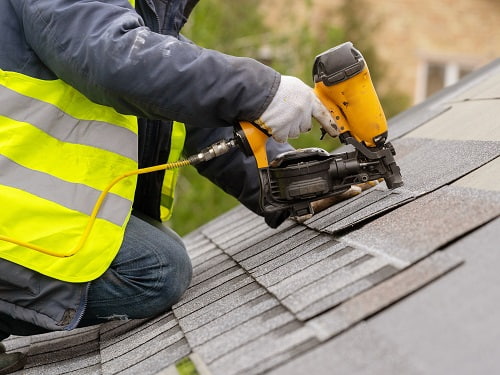Roofs provide protection from rain, snow, sunlight and extremes of temperature for buildings, but they also keep your house looking sharp.
There are various materials used for roofing, all with their own maintenance and installation that you can learn about below.
Materials
Materials used for roofing can have an enormous effect on its appearance and longevity. There are various options available, and a homeowner should select one that best matches their climate, home’s architecture and personal tastes. Some materials also contribute to greater energy efficiency within buildings.
Wood shingles and shakes, asphalt shingles, and clay tiles are the three most frequently used residential roof materials. These materials tend to be cost-effective alternatives that make sense in moderate climates; they also tend to outlast some other materials but may require more maintenance over time.
Metal roofs offer another viable option, and there are various varieties to select from. According to this roofing blog, steel is one of the most popular choices because of its durability, affordability and resistance to corrosion. Galvanizing increases this resistance even further while coating with aluminum or zinc can further add protection from further rusting. Furthermore, environmentalists may benefit from getting recycled-content metal roofs.
Other types of metal roofing materials are corrugated iron, copper, and terne plate (steel coated with lead and tin). While not as commonly used as other options, these roofing materials can make great additions to commercial properties with flat roofs. Corrugated iron is great for roofs that may be subject to snow or hail exposure as its strong structure makes it weatherproof while copper and terne plate offer unique aesthetic options that may add character.
Single-ply membranes can also be used on flat roofs. These come in thermoset form to minimize seams over large areas and thermoplastic form for smaller roofs; both varieties provide exceptional protection from bacteria growth, chemical environments, root penetration and extreme weather conditions.
Some single-ply membranes can be designed to look like traditional roof materials such as slate or cedar shakes, giving homeowners the beauty of these materials without their drawbacks.
Installation

Roofs provide shelter from rain, snow, sunlight and extremes of temperature for building inhabitants below them. Their design may range from flat roofs, pitched roofs, vaulted or domed designs based on technical considerations as well as economic or aesthetic ones.
Roof replacement can greatly increase the value of your home, and its installation process doesn’t need to be complex or costly. When selecting a contractor, keep several things in mind when making your selection: manufacturer credentialing, local references, licenses/bonds issued from authorities such as the Better Business Bureau rating as well as active certificates of liability or workers compensation insurance coverage.
Roof installation involves the placement of shingles and other materials on your property as well as its cleanup and restoration, including removal of old shingles, debris and packaging; recycling as much material as possible to promote sustainability, and leaving your home free from installation residue.
Open communication must remain paramount during this process to avoid confusion and reduce stress levels during its duration that will depend upon factors like roof size, weather conditions and other variables.
Maintenance
Roofs represent an investment that you need to protect, so proper care must be taken with their maintenance to extend its lifespan and keep energy costs under control. By following preventive maintenance protocols you can detect problems before they worsen and save yourself money over time by preventing leaks or other forms of damage that incur additional energy losses in your facility.
As we explore the wide range of materials suitable for roofing, it’s crucial for homeowners in specific regions, like Florida, to consider options that best withstand their unique weather conditions. For those in the Sunshine State, navigating through these choices becomes simpler with this comprehensive roof materials guide. This specifically addresses the challenges and needs of homes in tropical climates.
Building personnel should perform regular inspections of all roof surfaces, preferably on an annual or biannual basis (Spring and Fall), to detect problems early and initiate early repairs before deterioration takes hold of the system.
Clearing debris regularly from roof surfaces to avoid clogging that could pool water and cause further damage to roofing materials, is an essential maintenance task that should also be conducted on drains, scuppers and gutters.
Examining caulking on pipes and vents is another essential maintenance procedure. Any damaged caulking should be replaced immediately in order to avoid future issues; typically this task can be easily completed by facility staff.
Re-flashing is another maintenance procedure that should be carried out regularly to keep roof systems looking their best (https://www.roofingtalk.com/threads/replace-the-step-flashing.1236/).
Re-flashing can be conducted either as part of routine upkeep or following major weather events; replacing cracked, split, deteriorated or missing flashing is part of this procedure and can ensure proper sealant of penetration base flashings that help stop rainwater entering through roof systems.
Snow and ice accumulation can block drains and scuppers during wintertime, necessitating de-icing chemicals or heat tape to dislodge any blockages. Furthermore, chimneys should be checked for leakage as well as loose or defective flashing to ensure safe usage.
Routine maintenance can save your facility thousands by enabling early repair of small defects before they turn into larger issues, and by taking advantage of any deductibles available to you.
A comprehensive roof maintenance program can be developed and implemented either with the assistance of your building maintenance staff or hired as part of their service provision contract.
Repairs
Once a quick inspection is complete, it’s time to make any necessary repairs. Start with the obvious fixes such as missing, thinning or damaged shingles that should be taken out or replaced as soon as possible.
Flashing, which is typically hand-bent to fit specific applications, should also be checked and either removed or rebent as required. You may require tools like pry bars and shears as well as rubber gloves when handling these jobs.
As a final step, make sure you visit your attic or crawl space and perform an in-depth examination of the roof from within. Check for damp stains or peeling paint and photographs as needed of any areas that might need attention such as support trusses requiring repair or insulation which has lost effectiveness.
Doing this is often the only effective way of identifying problems which require attention. For instance, support trusses needing replacement or insulation losing effectiveness are some examples of issues which need addressing.
Re-roofing can be less costly than replacing, as it requires less materials and labor costs. However, keep in mind that this solution only acts as a cover-up and won’t last as long and professionals most likely need to be let in.











